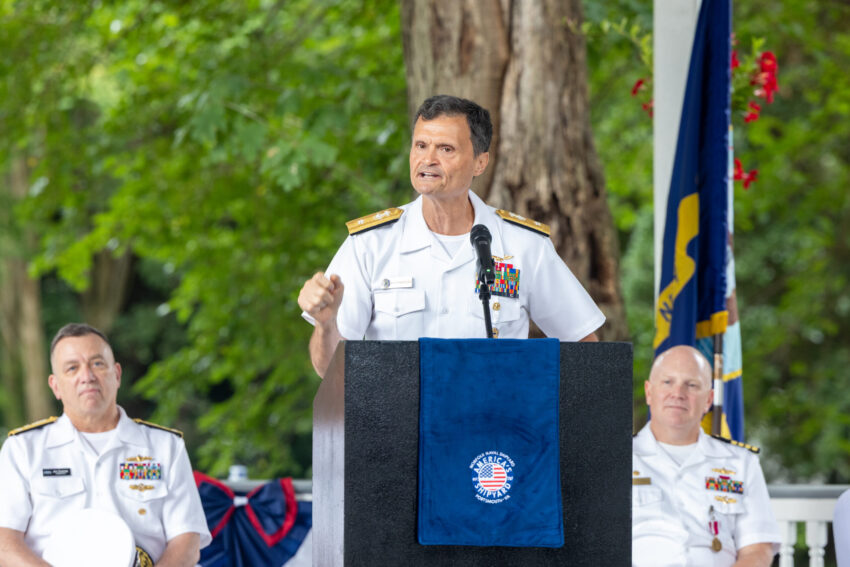WASHINGTON — Navy leadership is hoping that the one-star admiral taking command of a key public shipyard will help alleviate maintenance backlog issues and become a model to improve workflow for the other three public shipyards across the country.
The yard in question is Norfolk Naval Shipyard (NNSY) in Virginia, a key fleet concentration area and the headquarters for one of the service’s four-star operational commands, US Fleet Forces, to which NNSY’s commander, Rear Adm. Kavon Hakimzadeh, will now report. The new chief at the shipyard as of Aug. 8, Hakimzadeh returned to Virginia in June after serving as the commander of the Eisenhower carrier strike group during its deployment to the Red Sea.
His assumption as commander of the installation is unique for two reasons: The public shipyards are historically overseen by Navy captains, rather than one-star admirals, and the shipyard chiefs usually have backgrounds as engineering duty officers, whereas Hakimzadeh is a naval aviator who served as director of joint and fleet operations at Fleet Forces before leading a carrier strike group.
“The idea behind this is multi-fold. One [rationale] was bringing an operational perspective to the shipyard. … The operational requirement that is driving us to maximize the number of ships we have available in 2027,” Hakimzadeh told Breaking Defense in an exclusive interview Monday, referring to the year the Pentagon anticipates China wants to be ready to invade Taiwan. Navy leadership “wanted somebody who could bring that message to the team here, that sense of urgency.”
Another reason, he said, is to create a “bridge” between the operational and maintenance sides of the Navy, which he characterized as historically being “segregated.”
“You can’t just roll into a [maintenance] availability. You have to do a lot of prep work. You have to understand the functionality of the operating systems onboard the platform,” Hakimzadeh added. “And we were losing that time because there wasn’t a whole lot of bridging between the operational side and the maintenance side of the US Navy.”
That issue can cut both ways, the admiral said. For the fleet, while conducting maintenance at sea is a necessary task, crews tend to postpone or procrastinate completing it if they know the issue can wait until the end of the deployment when an availability is planned. That habit, Hakimzadeh said, puts an unfair amount of extra work on the shipyard, which is expected to plan for each availability — and gets the blame when things are delayed. One of the admiral’s goals will be to emphasize how problematic this habit is to operational commanders.
On the other hand, Hakimzadeh said that shipyard engineers sometimes chase “perfection” unnecessarily. The example he gave was measuring how many drips of fluid the seal on a pump leaks per minute. If that leak is more than two drips per minute, a shipyard engineer may deem it unacceptable and spend time trying to remedy it. But the fact may be that the crews responsible for monitoring that part of the ship know it functions equally as well even if it hasn’t met the standard an engineer might seek.
“This thing is dripping four times a minute, and it needs to only drip two times a minute, go back and rework it,” he said. “That could be weeks. That could add weeks to an availability. So, the idea is to bring an operator perspective.”
The admiral’s stationing at the shipyard is part of a one-year pilot program initiated by Vice Chief of Naval Operations Adm. Jim Kilby, Naval Sea Systems Command, Fleet Forces, and the commander of Submarine Forces. Hakimzadeh said a decision will likely be made after the first year whether the new setup is worth implementing at the other public shipyards.
Another part of Hakimzadeh’s role in this pilot program involves a change to the chain of command within the shipyard. While not all four public shipyards are identical in their structure, they all largely follow the same broad patterns. That includes having up to two dozen different shipyard officials reporting directly to the Navy captain in command. The admiral said service brass decided that this framework may be causing issues. As such, Norfolk will have a small group of captains take charge of different sectors of shipyard operations, and each of those captains will report to Hakimzadeh in an attempt to reduce the “span of control” for each officer.
Similarly, as the shipyard’s commander, the admiral will report operationally to Fleet Forces as opposed to his predecessor who reported to Naval Sea Systems Command.
“It’s that melding of the operational focus and the engineering focus,” Hakimzadeh said. “There’s no longer a hand off of the operational side flipping open the fence to the maintenance side and saying, ‘Yep, you need to get that back to me in 15 months. Ready, set, go.’ It’s now all owned by the same organization.”
Click this link for the original source of this article.
Author: Justin Katz
This content is courtesy of, and owned and copyrighted by, https://breakingdefense.com and its author. This content is made available by use of the public RSS feed offered by the host site and is used for educational purposes only. If you are the author or represent the host site and would like this content removed now and in the future, please contact USSANews.com using the email address in the Contact page found in the website menu.








